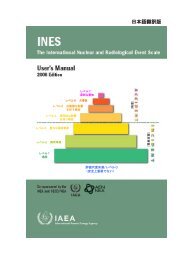Guidelines for Iodine Prophylaxis following Nuclear Accidents
Iodine_Prophylaxis_guide
Iodine_Prophylaxis_guide
You also want an ePaper? Increase the reach of your titles
YUMPU automatically turns print PDFs into web optimized ePapers that Google loves.
<strong>Guidelines</strong> <strong>for</strong> iodine prophylaxis <strong>following</strong> nuclear accidents1999 updateThe lifetime risk <strong>for</strong> adults would be 1/4 of the risk <strong>for</strong> children,because of the smaller number of years at risk.The most current estimate, based upon a pooled analysis includingfive cohort studies, gives an EAR of 4.4 × 10 -4 /Gy per year <strong>for</strong> personsexposed be<strong>for</strong>e the age of 15 (13). The study indicated the relative riskto be heavily dependent upon age at exposure, younger children beingat significantly higher risk than older ones. From the Lifespan Studyof atomic bomb survivors in Hiroshima and Nagasaki it is known thatlittle risk is indicated after the age of 20 and virtually none <strong>for</strong>exposure after the age of 40 (14).While internal exposure to radioactive iodine in medical use has notbeen shown to cause thyroid cancer in adults, the clinical experiencein the case of young children is very limited. The experience from theChernobyl accident shows the risk to be real. While the thyroidsensitivity in adults to both external radiation and 131 I seems to beminimal, or even absent in the elderly, sensitivity in young children ishigh.According to a recent dose–response analysis based on combined datafrom Belarus, Ukraine and the Russian Federation, the three countriesmost affected by the Chernobyl accident, the risk <strong>for</strong> those aged 0–15at exposure was 2.3 × 10 –4 /Gy per year with 95% confidence intervalsthat overlap those of the pooled analysis (13) (9). More recently ananalysis of time trends in thyroid cancer incidence in Gomel inBelarus (10) concludes that risk estimates from external exposure areconsistent with risk estimates from Gomel assuming that the increasein excess cases reaches a plateau soon. If this risk persists unchanged<strong>for</strong> 40–50 years, the lifetime risk of cancer would be about 1%/Gy.For public health purposes in emergency planning and response, it is,there<strong>for</strong>e, prudent to assume equivalence of carcinogenic effectbetween X-rays and radiation from 131 I.Radiation-induced thyroid cancer is not a trivial disease, although ithas a very low mortality if properly treated. It causes significantmorbidity and the treatment is lifelong, putting a considerable burdenon the health care system.6






